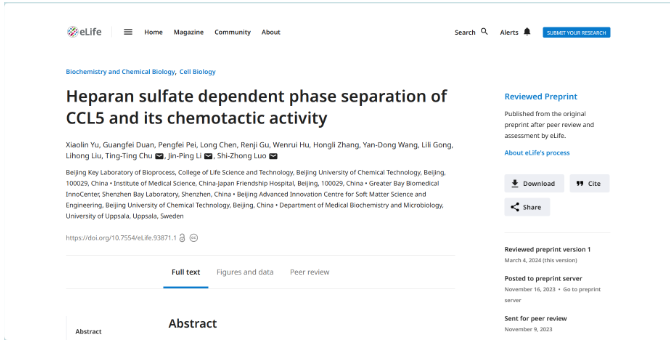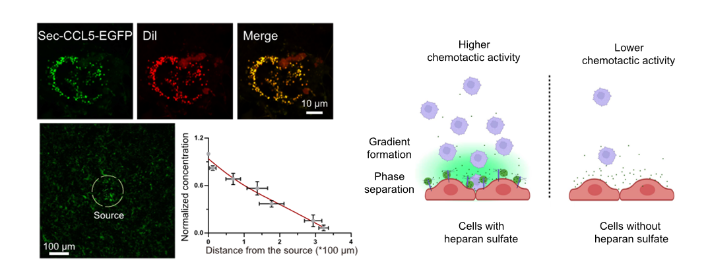
In March 5, 2024, the renowned journal eLife in the field of life sciences published online the latest research findings of Professor Luo Shizhong from the School of Life Science and Technology, Beijing University of Chemical Technology. The study titled "Heparan sulfate dependent phase separation of CCL5 and its chemotactic activity" reports on the coacervation of chemokine CCL5 with cell surface heparan sulfate and elucidates the role of cell surface heparan sulfate in forming chemotactic gradients.

The developmental biology study in animal models such as Drosophila has experimentally demonstrated the involvement of proteoglycans like heparan sulfate and chondroitin sulfate in the formation of morphogen concentration gradients. In the context of inflammation, researchers propose that inflammatory factors also form concentration gradients to guide leukocyte migration. It is known that many chemokines interact with heparan sulfate (HS), but evidence regarding the role of HS in the formation of chemokine gradients is lacking.
Liquid-liquid phase separation (LLPS) serves as the basis for the formation of cellular condensates and membrane-less organelles. In this study, the formation of concentration gradients of HS-dependent chemokine CCL5 and its chemotactic effects on cells have been shown to be mediated by LLPS. Cellular imaging and chemotaxis experiments suggest that CCL5 secreted at its source binds to HS through LLPS, leading to diffusion, gradient formation, and monocyte migration. This work reveals a new mechanism for the HS-dependent formation of chemotactic gradients.
Professor Luo Shizhong from the School of Life Science and Technology at Beijing University of Chemical Technology, Professor Li Jinping from the Soft Matter and High-Tech Center at Beijing University of Chemical Technology, and Researcher Chu Tingting from the Shenzhen Bay Laboratory are the corresponding authors of this study. PhD students Wei Xiaolin and Duan Guangfei are co-first authors, and Beijing University of Chemical Technology is the first completing unit of the paper. This research was supported by the National Natural Science Foundation of China and the Ministry of Science and Technology's National Key R&D Program.
Corresponding author's bio:
Shizhong Luo, professor and doctoral supervisor. Graduated from the Department of Chemistry at Tsinghua University with both bachelor's and doctoral degrees. He was awarded the Outstanding Doctoral Dissertation Award from Tsinghua University and later conducted postdoctoral research at the University of Texas in the United States. He joined Beijing University of Chemical Technology's School of Life Science as a high-level talent. His research mainly focuses on peptides and protein engineering. He serves as the chief scientist for the National Key Research and Development Program of the Ministry of Science and Technology, and has undertaken major research projects funded by the National Natural Science Foundation, international cooperation projects, and general projects. He is also involved in cross-cutting projects with Qilu Pharmaceutical, Sinopec, and Beijing Kain Biotechnology Company. As the corresponding author, he has published over forty SCI papers in renowned journals such as Nature Communications and Science Advances. He has been awarded the third prize of Beijing Science and Technology, Beijing Science and Technology Rising Star, Beijing Excellent Teacher for Ideological and Political Education, and the Young Peptide Scientist Award at the China International Peptide Conference.


